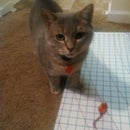Introduction: Custom Padded Bicycle Seat Cover
One might assume I have enough "built-in" padding to prevent a sore butt when biking. Nope. Also, I could stand to have a layer between me and the seat and my sweat. Why not make a bicycle seat cover?
Skill Level: EASY
Step 1: What You Will Need
Roll of wrapping or butcher paper
Measuring tape
Ruler or yardstick
Marker
Paper scissors
Fabric scissors
Sewing pins
1 yard woven cotton fabric (pre-washed and pre-shrunk)
1/2 yard cotton or polyester batting
Thread
Sewing machine
Iron and ironing board
1 yard 3/8" wide ribbon
Safety pin
Step 2: Measure the Bike Seat
Take your measuring tape and get the following measurements from your bike seat:
1- Length of seat from bottom lip to bottom lip (view A)
2- Width of seat at narrowest point, from bottom lip to bottom lip (view B)
3- Width of seat at midpoint, from bottom lip to bottom lip (view C)
4- Width of seat at widest point, from bottom lip to bottom lip (view D)
Also take note of approximately where measurements 2, 3 and 4 intersect with measurement 1.
Step 3: Draw and Cut Your Pattern
Using your measurements from the previous step, draw the basic outline of the seat on the backside of your wrapping paper (I use the kind with a grid on the back, it really helps- view A). I started with a vertical line in the center (measurement 1), then added the widths appropriately (view B). Round edges to the curve of the seat (view C). Add 1/2" seam allowance to edges (view D). Use your paper scissors to cut out the pattern.
Step 4: Cut Your Fabric Pieces
Grab your measuring tape again and use it to measure the "circumference" of the bike seat pattern. Mine came out to 44". That just happens to be the width of my fabric, so I totally lucked out. Next, cut a rectangle of fabric as wide as the distance around the bike seat pattern, and 5" long (view A).
Now fold your fabric in half such that printed sides are out and wrong sides are touching. Pin your pattern to the fabric (view B) and cut out two bike seat pieces (view C).
Step 5: Cut and Prepare Your Batting Pieces
Take your seat pattern piece and trim off the seam allowance with paper scissors (view A). Decide how many layers of batting you want to use (I chose four) and pin the pattern through all layers of the batting (view B). Cut out the batting pieces with fabric scissors (view C). To prevent slippage in use, sew the layers of batting together using 1/2" seam allowance* (view D). Then, trim as close as you can to the seam without cutting through it (view E).
*You may notice I am using a plastic presser foot rather than my regular metal one. This is only while I am sewing the layers of batting together; the plastic foot slides better over nappy fabrics than a metal one would.
Step 6: Quilt the Padded Pieces
To prevent slippage while in use or in the wash, it's important to quilt the batting pieces with the cotton fabric. First, lay one piece of fabric on your flat surface such that the right (printed) side is down, and place the layers of batting centered on top of it (view A). Next take the other piece of fabric and position it on top of the batting with right side up; pin all layers together (view B). You can quilt the layers in a fancy design if you like; I'm just going to do a simple five-line grid (view C).
Step 7: Construct the Drawstring Casing
Now move your long strip of fabric over to the ironing board and press one long side under about 1/4"-3/8" (view A). Fold the pressed edge under once more about 5/8"-3/4" (view B); this will help when you stitch down your casing. That's exactly what we do next: take the strip of fabric over to the sewing machine and set the pressed edge such that you can stitch down the pressed edge as close to the edge as possible while still capturing all layers of fabric. When sewing, leave about 1/2" of space unstitched at each end (view C).
Step 8: Sew Bottom and Top Pieces Together
Find the center of your long strip of fabric and pin it to the front center point of the quilted cover top, making sure to match right sides and unfinished edges (view A). Continue pinning the pieces together all around (view B). Using 1/2" seam allowance and a straight stitch, sew bottom and top pieces together, capturing all layers (view C). Now go back with a zigzag stitch and sew again right next to your last seam (view D). Trim excess fabric without cutting through the zigzag seam (view E).
Now we have a short length of seam to stitch at the back (view F). Match right sides together and use a straight stitch first down to the casing (view G), then go back with a zigzag stitch as we did around the top piece (view H). Trim excess fabric without cutting through the zigzag seam, and leaving about 3/4" extra at the casing (view I).
Step 9: Thread Casing and Tie on Seat
Turn your seat cover right side out (view A). Attach the safety pin to one end of the ribbon (view B). Thread the ribbon through the casing (view C). Put the seat cover on your bike, pull the ribbon tight, and tie in a knot (view D). You're done!













